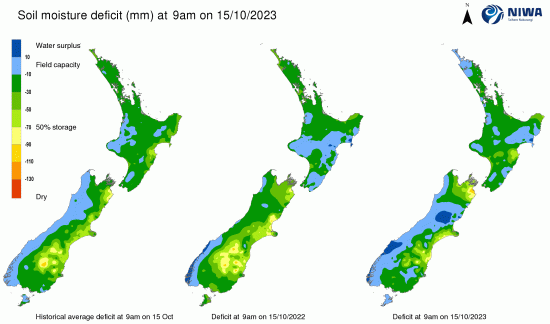Here’s our summary of key economic events overnight that affect New Zealand, with news the threat of the Chinese economic slowdown hangs over the global economy and now they are staring at imminent deflation.
But first we should note, there was a right-shift in the political mood evident in weekend voting in both Australia and New Zealand. There is also a key election going on in Poland that is worthy of our attention. Locally, early celebrations by the winning parties may be followed by nervousness, as the late and overseas votes get counted. It may herald complex coalition negotiations.
Coming up this week, the big economic issue will be the release of our inflation rate for Q3-2023 on Tuesday. Markets currently expect the headline CPI rate to be 5.9%, down only marginally from 6.0% in Q2-2023. But if it does come in at that level, that will represent no material progress from the RBNZ’s perspective.
In the United States, a key focus will be on the onset of the earnings season featuring major players like Tesla, Bank of America, Johnson & Johnson, Procter & Gamble, and Netflix. Also, investors will be paying attention to Fed speeches, and data including retail sales, building permits, housing starts, existing home sales, and industrial production.
Across the Pacific, China will grab attention this week with its Q3 GDP growth rate, retail sales, industrial production, fixed asset investment, unemployment rate, and house price index.
Over the weekend, Chinese consumer prices were unexpectedly unchanged in September from a year ago, missing market forecasts of a +0.2% gain. Meanwhile their PPI fell -2.5% in September from a year ago.
Exports from China declined by -6.2% from a year ago to US$300 bln in September, which was an improvement from the -8.8% drop in August and compares with the market’s expected -7.6% decrease. This marked the fifth consecutive month of declining exports but was the least severe in the series. However, the result was underpinned by a very sharp +21% rise to Russia. Exports to normal countries were all very weak; to the US down -9.3%, the EU down -11.6%, to Japan down -6.4% and to Australia down more than -17%. This is a sign of the international trading blocs sharply cleaving.
And staying in China, the IMF is warning there are heightened spillover risks from the country’s property woes. The failures are famous; but there are actually less of them, especially domestic bonds in stress.
In Singapore, their central bank announced it would shift from half-yearly monetary policy reviews to quarterly.
Indian exports were marginally lower in September and slipped -2.5% from a year ago. India however is not a powerhouse exporting force yet, exporting only an eighth of the goods that China does. And there is little indication Indian exports are firing up.
In Asia generally, more key central banks are worried about the US ‘higher-for-longer’ rate threat from the US, one that could sharply weaken their currencies because their local interest rates are lower than the US. They are addressing that with aggressive bond selling moves to soak up cash to defend their currencies. India, China and Indonesia have already ramped up these activities. Watch out for similar moves by Korea, Malaysia, the Philippines, and possibly Thailand in the next few months. But a bond rush like this does come with other risks for them.
In the US, consumer sentiment as monitored by the widely-watched University of Michigan survey fell rather sharply in October. It fell to an index level of 63 this month from 68.1 in September, the lowest in five months, and missing market estimates of 67.2. But to be fair it is still well ahead of year-ago levels and it has been in this general range since late 2021. However, it’s lower-than-expected reading has moved financial markets in the US.
The UST 10yr yield starts today little-changed from Saturday at 4.62% which is -16 bps lower than a week ago. Their key 2-10 yield curve is still by -44 bps. Their 1-5 curve is also still at -76 bps. Their 3 mth-10yr curve inversion is holding at -82 bps. The Australian 10 year bond yield is now at 4.44% and unchanged from Saturday. And the China 10 year bond rate remains at 2.72%. The NZ Government 10 year bond rate is also holding at 5.51%. A week ago it was at 5.61%.
The price of gold will start today at US$1933/oz and up another +US$5/oz from this time Saturday. That has cumulated to a heady +5.7% rise for the week.
Oil prices have risen a further +50 USc/bbl from Saturday to be now at just on US$86.50/bbl in the US. The international Brent price is now just on US$90/bbl. A week ago these prices were US$82 and US$84 respectively.
The Kiwi dollar starts the week weak at 58.8 USc and down marginally after Saturday’s drop, as commodity currencies stay out of favour. Recall a week ago this rate was 60 USc so more than a -1c fall for the week. Against the Aussie we are slightly softer at 93.5 AUc. Against the euro we are down to 56 euro cents. That all means our TWI-5 starts today at under 69.2 which is down -10 bps from Saturday and down -70 bps for the week.
The bitcoin price starts today at US$26,925 which is up +0.8% from this time Saturday. Volatility over the past 24 hours has again been virtually non-existent at +/-0.2%.
Select chart tabs
The easiest place to stay up with event risk is by following our Economic Calendar here ».




